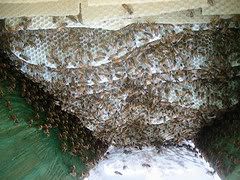I found the TBH queen! (photos)
Captured hive:
They've done extensive drawing of comb in the last two weeks. The nuc is just about full but, given there temperment is starting to show and, they aren't large enough to even build up for winter on their own, I've decided that I will have to kill this queen and combine it with the italian hive. This is the part that every beekeeper hates but, given I am in an urban area, I can't have any tollorance for overly deffensive bees.
Italian hive:
The cabbage palm honeyflow is on. It's really a poor honey. The bees never seem to get anywhere near the 18% moisture necessary for honey. It usually is capped around 21%. Some of the people at the TBBA have said that this will cause fermentation and, they've seen the tops pop off barrals from the pressure. As for the hive itself, they've drawn out 7 out of ten frames of a super, so I added another. Now there's 1 super of foundation, 1 super mostly drawn with ripening honey and 2 supers ready for extraction. Down in the brood box, the queen has a much improving brood pattern. She's laying in the perfet football shape on 7 of the frames. In my book, she's earned another year of leading this hive (contrary to most recomendations of annual requeening).
Russian hive:
Thses bees NEED requeening. This seems to be the worst hive of the bunch. They have bad frames and, even the good ones have bad comb. They're also becoming more deffensive. I've concidered requeening them for some time, so, I guess that time has come. I'll probably replace the current queen with an italian queen. Italians seem to ALWAYS be nicer, more productive and draw comb faster and more completely. Not much to report on this hive except my general dissatisfaction of all the above.
Package hive:
This hive is rapidly expanding. They've got 3 frames full of honey and pollen and the rest is almost solid brood. Next year this should be one of my big producers.
TBH:
Here comes the fun part. These bees have been wonderfull and, I finally today have a picture of the queen. Last time I got a good look at her, I was shaking the swarm of bees into the hive body. The bees are on bars 1-15 with bars 1-8 75% or more drawn. I'm starting to see how the bees transition from a core brood area of nothing but workers to farther back in the hive, around bars 10 or 11, where it's almost all drones. After that, comes the honey. There must be a good flow going on given, they're drawing out wonderfully, and, so many of the combs are filled with ripening honey. As of today, the bees are actively present in half the hive.
HERE COMES THE GOOD PART...PHOTOS!

Here you can see my usuall photo of the cluser of bees expanding. All that white comb is freshly drawn, indicating to me that there is currently a honeyflow;cabbage palm. I think I'll let the bees eat if...

Heres bar 12. The queen was on this bar. This bar had less than a dozen cells with brood and, I didn't find a single egg. There was, however, alot of ripening honey and even come capped.

Here's "her highness" her self.

Here's the last shot of the photogenic queen. She's scurrying over the top bar but, I did manage to get this shot of her abdomen. She seems to be on of the largest queens I've ever seen and, she's deffinately one of the most productive...

...just check out that brood pattern. Nothing but workers! bar 7.

Here's bar number 4. The cells are quite a bit darker from the generations of bees being raised in them.
Final note: If you want to see larger versions of these photos go to http://flickr.com/photos/backyardbeekeeper
3 Comments:
I'm totally intrigued by top bar hives! Maybe next year!
I have 5 hives in three places (you could even say two states!), all Langstroth hives.
Thank you for stopping by and saying hello! I added you to my blogroll, and wish you all the best with your bees!
I'm honored that you valued this site to add it to your "blogroll". Top bar hives are certainly a great deal of fun and, if you like, I can scan the scematics for my TBH to compare with others. I designed the body to be wider but shallower to compensate for the heat of florida.
I have added you as a link to my blog, trust that is OK. www.mellifera.blogspot.com
Post a Comment
<< Home